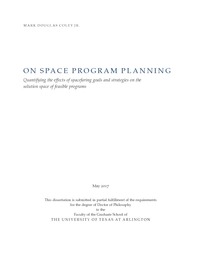
ATTENTION: The works hosted here are being migrated to a new repository that will consolidate resources, improve discoverability, and better show UTA's research impact on the global community. We will update authors as the migration progresses. Please see MavMatrix for more information.
Show simple item record
| dc.contributor.advisor | Chudoba, Bernd | |
| dc.creator | Coley, Mark Douglas | |
| dc.date.accessioned | 2018-04-02T13:50:03Z | |
| dc.date.available | 2018-04-02T13:50:03Z | |
| dc.date.created | 2017-05 | |
| dc.date.submitted | May 2017 | |
| dc.identifier.uri | http://hdl.handle.net/10106/27294 | |
| dc.description.abstract | An organization's space program represents the coalescence of top-level goals and strategies with the specific, lower-level combinations of mission architectures, hardware, and technology. High costs and long lead times necessitate substantial planning and key decisions to be made years, possibly decades, in advance.
Unfortunately, the methods and processes available for planning have historically been unable to provide decision-makers with objective, quantitative information from both the top and lower levels of the space program. Instead, decision-makers are forced to turn to top-level, qualitative assessments, disconnected from any of the fundamental, technical details, where inconsistent comparisons and secondary effects often become the basis of decisions. This leads to misinformed decisions early on that will have the largest impact on the overall cost and schedule of the program. Similarly, the systems designers and specialists at the lower, technical levels are disconnected from any guidance from the over-arching goals of the program. Therefore, these technical efforts tend to be pursued and optimized separately from the space program as a whole.
It is the hypothesis of this research that this disconnect exists but can be parametrically corrected to better support the decision-makers at all levels of a space program. In pursuit of a solution, a prototype decision-support system, Ariadne, has been developed to parametrically integrate the top-level effects of goals and strategies with the primary technical details of mission architectures and hardware designs. The capabilities of this prototype system are demonstrated with a case study of Project Apollo, enabling informed decisions concerning launch vehicle requirements, mission architecture selection, and alternative candidate space programs. | |
| dc.format.mimetype | application/pdf | |
| dc.language.iso | en_US | |
| dc.subject | Space program | |
| dc.subject | Planning | |
| dc.subject | Mission architecture | |
| dc.subject | Strategy | |
| dc.title | On space program planning: quantifying the effects of spacefaring goals and strategies on the solution space of feasible programs | |
| dc.type | Thesis | |
| dc.degree.department | Mechanical and Aerospace Engineering | |
| dc.degree.name | Doctor of Philosophy in Aerospace Engineering | |
| dc.date.updated | 2018-04-02T13:50:03Z | |
| thesis.degree.department | Mechanical and Aerospace Engineering | |
| thesis.degree.grantor | The University of Texas at Arlington | |
| thesis.degree.level | Doctoral | |
| thesis.degree.name | Doctor of Philosophy in Aerospace Engineering | |
| dc.type.material | text | |
| dc.creator.orcid | 0000-0002-2007-9970 | |
Files in this item
- Name:
- COLEY-DISSERTATION-2017.pdf
- Size:
- 8.387Mb
- Format:
- PDF
This item appears in the following Collection(s)
Show simple item record


